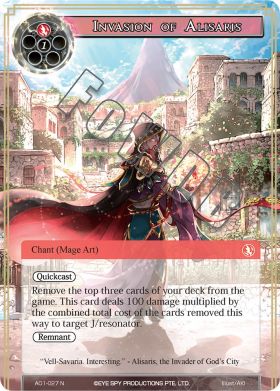

From that point onward, the card is a J-ruler. If that ruler is in a ruler area, the player who performed the judgment puts their ruler into the field under their control, J-ruler side up. When a Judgment process on the chase resolves, perform the following procedures. Any effects applying to spells or abilities don't affect judgment. Judgment in a chase area is neither a spell or ability. If a text refers "", it refers "actions written in the section". If any conditions are shown on this section, they are conditions that need to be met to play the judgment process. If will symbols are shown in this section of the card without specific notice, you need to pay the will to perform a judgment. The player performs any action specified in the section and put the judgment into the chase area. The turn player may play a judgment process if it is main timing, they have a recovered ruler with in their ruler area, and they haven't played a judgment process this turn. Initiating battle doesn't use the chase area. Turn player may initiate battle if it is main timing. When a chant in the chase area resolves, perform the text and put it into its owner's graveyard. Unless otherwise specified, they can play chant cards from their hand only. The player chooses a chant card without, pays the cost and plays it. Turn player may play a chant without if it is main timing. When a resonator, regalia, or addition card in the chase area resolves, the resonator, regalia, or addition card is put into the field under its controller's control. Unless otherwise specified, they can play a resonator, regalia or addition cards from their hand only.

The player chooses a resonator, regalia or addition card, pays the cost and plays it. Turn player may play a resonator, regalia or addition card if it is main timing. In the rules, "main timing" means "turn player has priority, it is their main phase, they are not in a battle, and the chase area is empty." A player may perform an action while they has priority. The first player is becomes the turn player, and begins the turn. The first player must choose which cards to change first. Then each player moves chosen cards they wish to change to the bottom of their main deck in any order, then move that many cards from the top of their main deck to their hand. Then, the player who chose to play first chooses to change any cards in their hand, then the other player does the same. Each player moves the top five cards from their main deck to their hand. Players must decide who plays first randomly, and cannot choose to take the first or second turn. Choose a player at random and that player must take the first turn. Each player puts their extra deck into their extra deck zone. Each player puts their ruler into their ruler area. Each player sets their life points to 4,000. Before the game, each player shuffles their main deck and magic stone deck and puts each of them into the main deck zone and magic stone deck zone, respectively. During a game, even if the ability that produces that effect is lost, the deck is still legal. If an effect replaces the deck building rules, it affects the rules only at this time. Non-special magic stone cards are the exception to this rule and you can put any number of them in a magic stone deck (as long as the total number of cards in the magic stone deck does not exceed 20).402.7.

Between the main deck and the extra deck, you may only share four cards with the same name. In a extra deck, you may have up to one copy of any card with the same name. In a main deck or magic stone deck, there can be up to four copies of any card with the same name. Currently, if your ruler does not have, then you may not have cards in your extra deck. The extra deck must contain from zero to five cards. The extra deck is a pile of cards that can not include magic stones and rulers. A magic stone deck must contain no less than ten and no more than twenty cards. A magic stone deck is a pile of cards containing only magic stone cards. A main deck must contain at least forty cards and no more than a maximum of sixty cards. A main deck is a pile of cards that contains cards other than a ruler or magic stones. Each player prepares exactly one ruler card. Each player prepares their main deck, magic stone deck, and a ruler card. Before the game, each player constructs their deck and prepares for the game.


 0 kommentar(er)
0 kommentar(er)
